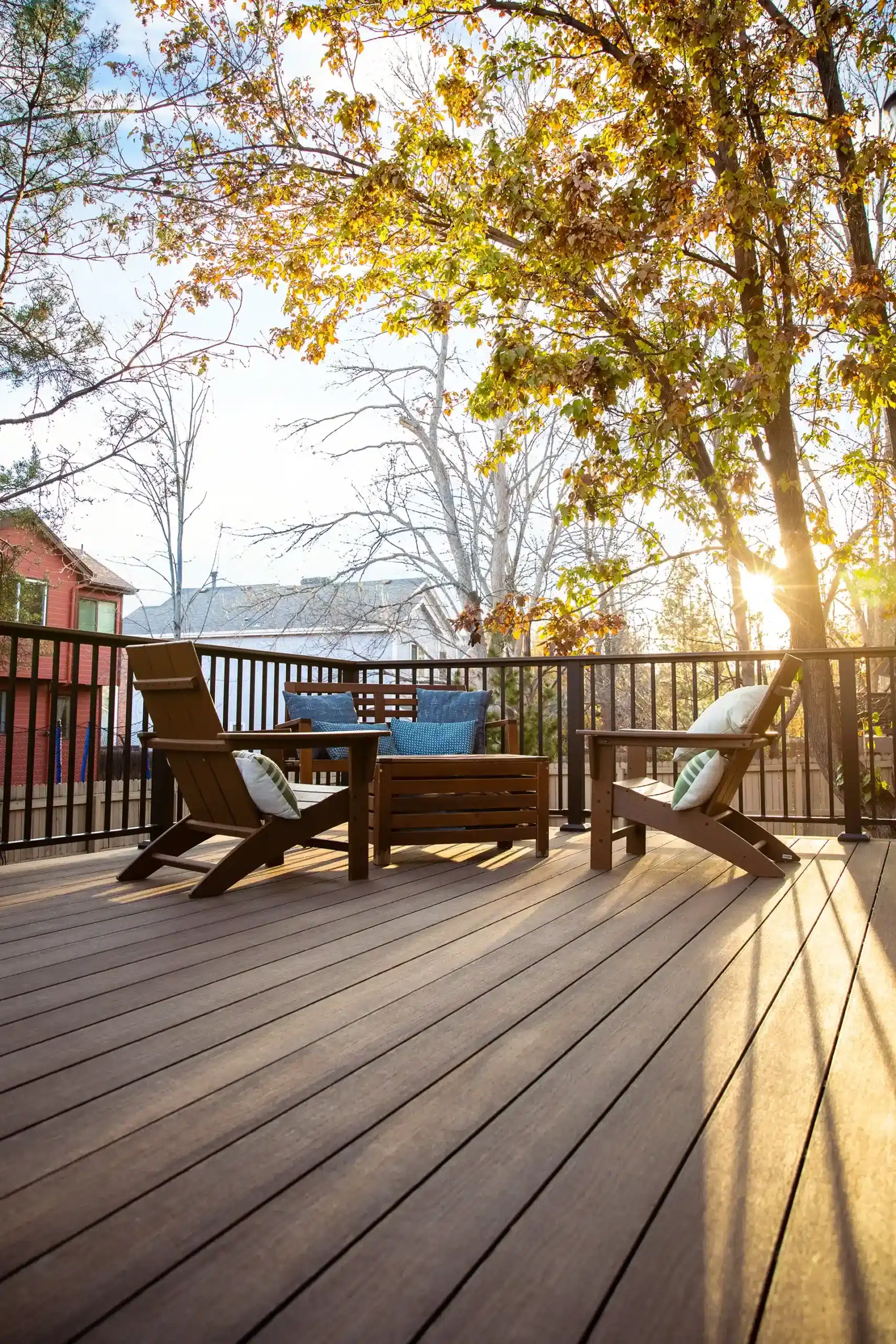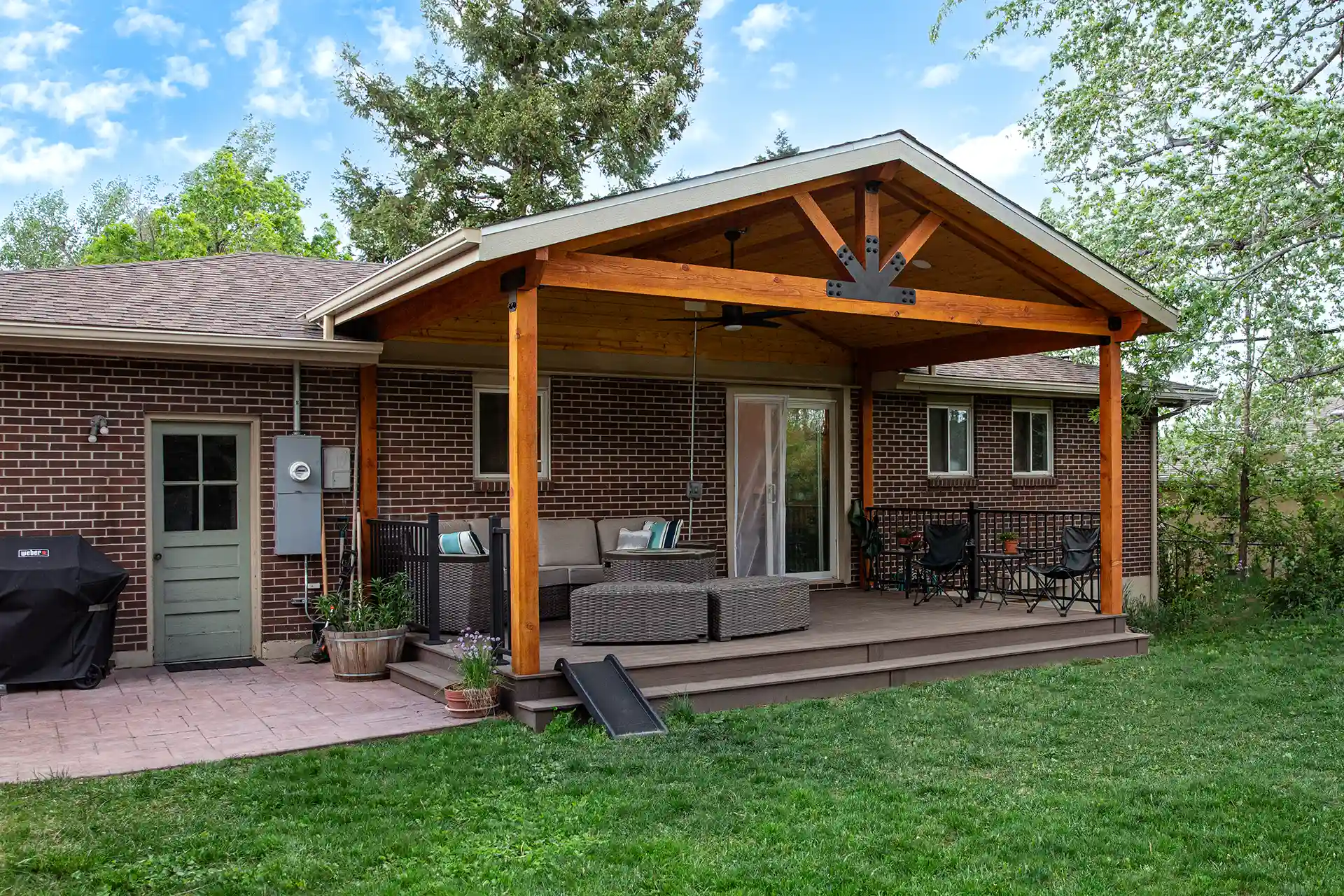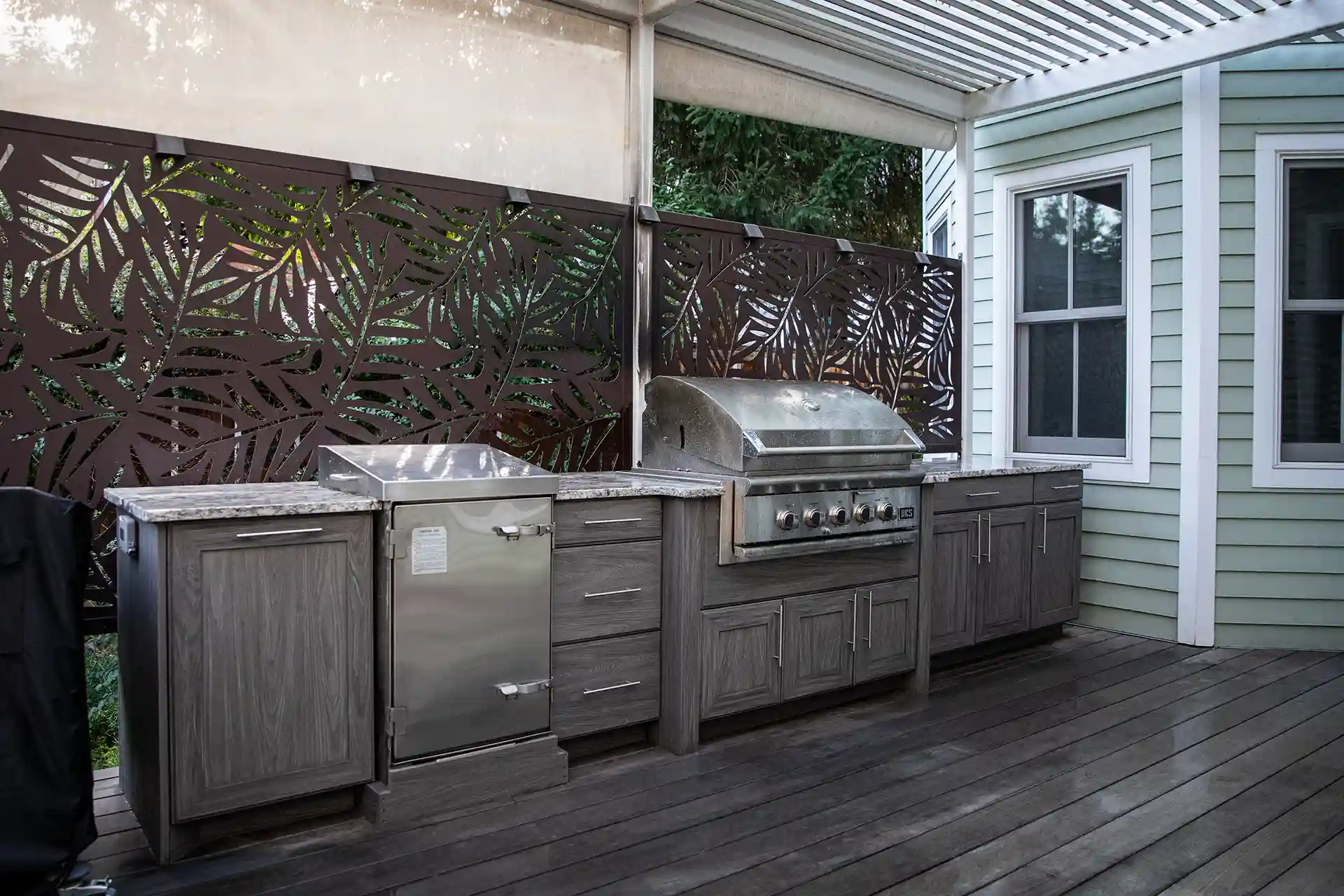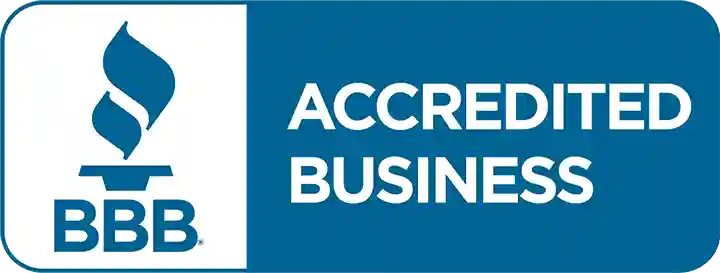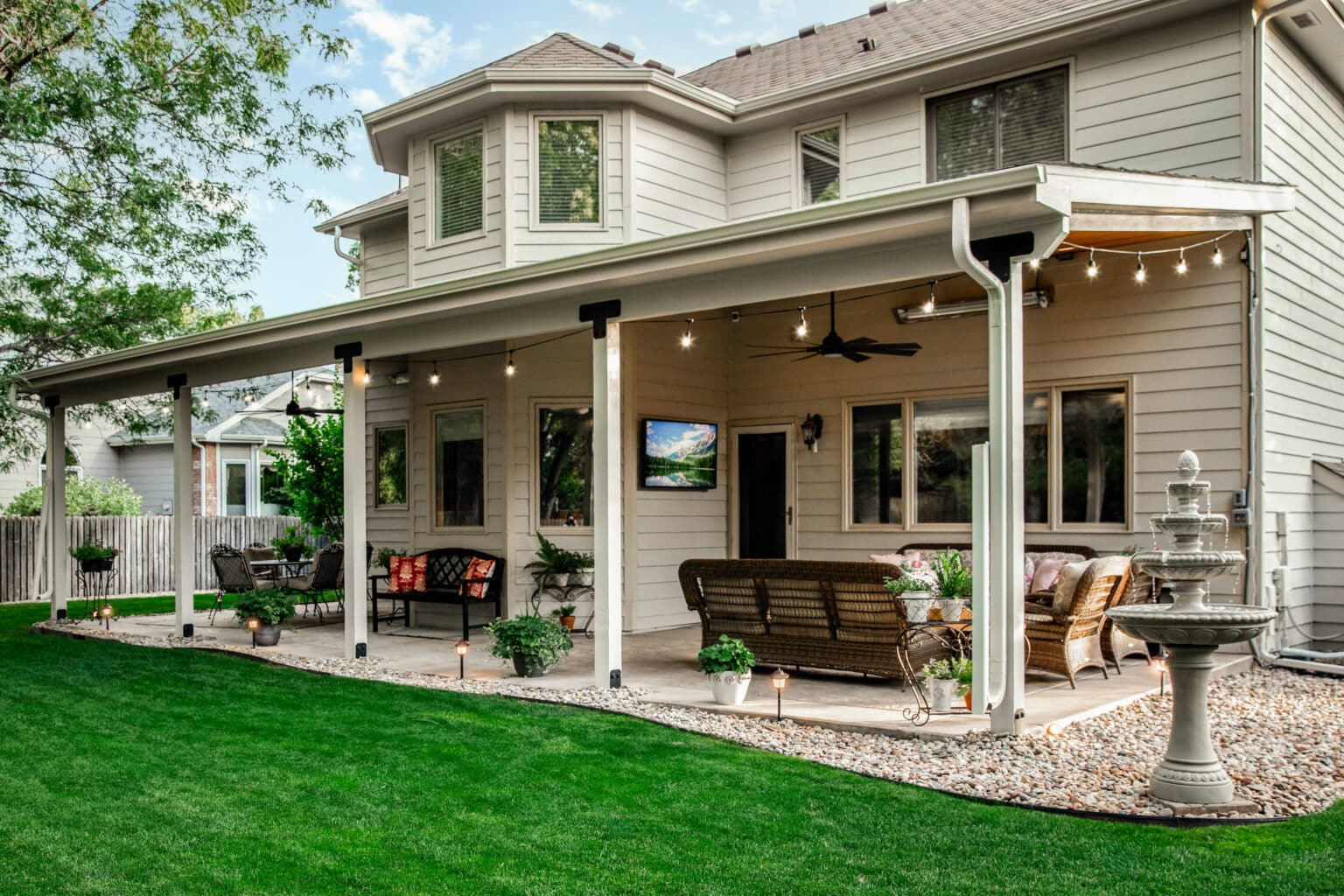Loveland summers bring plenty of sunshine, along with it the challenge of keeping your deck comfortable during the hottest parts of the day. A deck that heats up too much can limit your outdoor enjoyment, but using the right materials and innovative design from an experienced deck builder can keep your space cool.
If you’re planning new deck construction or improving an existing deck, working with a skilled deck contractor will help ensure your deck stays comfortable all season.
Why Does Your Deck Get Hot in the Summer?
Deck surfaces absorb solar radiation throughout the day, especially on south- and west-facing decks. Because Loveland sits at about 5,000 feet, UV rays are more intense than at sea level, causing boards to heat up faster and stay hot longer. Materials with low reflectivity and high density trap heat, and stagnant air around and beneath the deck surface prevents cooling.
Best Materials to Keep Your Deck Cooler
- Composite Decking: Brands like Trex, TimberTech, and Deckorators use capped or mineral-based composites to reflect sunlight and resist heat buildup. Mineral-based composites offer cooler surfaces due to air pockets and mineral fillers, which reduce thermal conductivity.
- PVC Decking: Fully synthetic and highly moisture resistant, PVC decking reflects more heat, especially in lighter colors, and cools faster than wood composites.
- Wood Decking: Dense hardwoods such as Ipe and Cumaru absorb and hold more heat, while softer woods cool faster but can still become warm. Choosing lighter stains and maintaining sealants can reduce heat retention.
- Aluminum Decking: Highly reflective and durable, aluminum decking stays cool but is less common in residential decks.
Wood Decks and Heat: Understanding Natural Materials Under the Sun
Wood decking is prized for its natural look and feel, but when it comes to summer heat, its properties can make it warmer than many synthetic alternatives. Here’s what affects wood decks in the sun:
Wood Density and Heat Retention
The density of wood plays a significant role in how much heat it absorbs and how long it holds onto that heat:
- Hardwoods such as Ipe, Cumaru, and Tigerwood are very dense. These woods absorb significant heat during the day and release it slowly, sometimes keeping your deck uncomfortably warm well into the evening.
- Softwoods like cedar, redwood, and pine are less dense, meaning they heat up faster and cool down quicker. However, they can still become quite hot under direct sunlight if stained dark.
Grain Structure and Moisture Content
- Wood with a high moisture content tends to retain heat longer. Moisture acts as a thermal mass, slowing the rate at which the wood heats up and cools down.
- The grain orientation and surface texture affect heat absorption. Smooth, tight-grained woods absorb less solar radiation on the surface than rough, open-grain woods, but finishing methods can alter this dynamic.
Finishes and Stains: How They Affect Deck Heat
- Dark stains and paints reduce wood’s reflectivity, causing the surface to absorb more heat. Solid-color stains tend to hold heat more than transparent or semi-transparent finishes.
- Clear or lightly tinted sealants allow more sunlight to penetrate the wood surface, which can cause deeper heat absorption but may reduce surface temperature compared to solid dark finishes.
- Applying UV-resistant sealants regularly helps protect wood from sun damage, cracking, and warping—issues exacerbated by prolonged heat exposure.
Maintenance Tips to Manage Heat
- Sanding can smooth the surface and reduce heat absorption, but it must be done carefully to avoid removing protective sealants.
- Reapplying sealants every one to two years maintains UV protection and moisture resistance.
- Pair wood decks with overhead shading or pergolas to reduce direct sun exposure, which can dramatically lower surface temperatures.
Shade Strategies: Blocking Heat at the Source
Providing shade over your deck is one of the most effective ways to reduce heat buildup and create a comfortable outdoor environment during Loveland’s sunny summers.
Covered Decks: Full Protection From Sun and Weather
A covered deck roof blocks all direct sunlight, lowering deck surface temperatures by up to 40°F during the hottest part of the day.
Why it matters:
Covered decks protect your deck materials from sun damage and rain, extending their lifespan. This option supports adding ceiling fans, lighting, and retractable Hideaway Screens, making your outdoor space usable year-round.
What to expect:
Covered deck construction requires solid framing and roofing materials suited to Loveland’s climate. It’s typically a larger investment, but it provides consistent, reliable shade.
Pergolas: Filtered Shade That Still Lets Air Flow
Pergolas reduce sun exposure by 50–70%, depending on the spacing of rafters and orientation.
Why it matters:
They balance shade and openness, allowing cooling breezes to pass through. Adding retractable fabric covers or growing climbing plants increases shade without sacrificing airflow.
What to expect:
O’Keefe Built offers professional pergola installation, construction, and integration with Hideaway Screens for extra sun and insect protection. Pergolas are a flexible and cost-effective option to upgrade your deck’s comfort.
Louvered Roof Systems: Adjustable Shade on Demand
Motorized or manual louvered roofs let you control sunlight and ventilation throughout the day.
Why it matters:
This system responds to weather changes, providing sun protection when needed and opening up for light and air when preferred.
What to expect:
Louvered roofs require professional installation and electrical integration. They are ideal for homeowners seeking customizable shade solutions.
Patio Covers: Durable Protection to Reduce Deck Heat
Patio covers are fixed overhead structures blocking sunlight and shielding decks from rain, snow, and UV exposure. They reduce deck surface temperature by limiting solar heat gain and protect materials from weather-related damage.
Why it matters:
Blocking direct sun reduces heat buildup by up to 70%, preventing warping, fading, and material degradation common in high-altitude areas like Loveland.
What to expect:
Materials include pressure-treated wood, aluminum, and vinyl. Wood requires regular sealing to prevent rot and insect damage. Aluminum is corrosion-resistant and low-maintenance. Vinyl offers durable, UV-resistant protection with minimal upkeep.
Installation requires a correct roof pitch for drainage, secure framing for snow and wind loads, and integration with home gutters. Optional features include built-in lighting and retractable screens for adjustable sun control.
Movable Shade Options: Flexible Protection for Changing Sun
Movable shade solutions let you adjust the amount of sun your deck receives throughout the day or season. These options are ideal if you want control and flexibility without permanent structures.
Retractable Awnings: Shade When You Need It
Retractable awnings attach to your home or deck and can be extended or retracted based on sun exposure.
Why it matters:
You get sun protection during peak hours but can enjoy full sun when preferred, helping balance shade and brightness.
What to expect:
Awnings use durable, UV-resistant fabrics that resist fading and light rain. Motorized models can automate deployment based on sunlight or wind sensors. Regular cleaning and maintenance keep them working smoothly.
Cantilever Umbrellas: Targeted Shade, No Obstruction
These offset umbrellas provide shade without a center pole, leaving open space underneath.
Why it matters:
Perfect for shading dining or seating areas without interfering with foot traffic or furniture layout.
What to expect:
They adjust to follow the sun’s movement and are made from UV-resistant fabrics and sturdy frames. Secure anchoring is important to withstand Loveland’s occasional winds.
Shade Sails: Stylish and Breathable Shade
Shade sails are fabric panels stretched between anchors to cover larger or oddly shaped deck areas.
Why it matters:
They block up to 95% of UV rays while allowing air to flow freely beneath, keeping your deck cooler.
What to expect:
Made from durable, UV-stable materials, sails should be removed during harsh weather to prolong their lifespan. They can be arranged creatively for custom coverage.
Built for Colorado Summers, Crafted for Lasting Comfort
At O’Keefe Built, we don’t just build decks — we engineer outdoor living solutions tailored to Loveland’s unique climate. Using cutting-edge materials and smart shading designs, we create decks that stay cooler, resist wear, and extend your outdoor enjoyment year-round. Experience the difference of a deck designed to handle Colorado’s sun and deliver unmatched comfort.
Green Cooling: Using Plants to Naturally Cool Your Deck
Plants don’t just add beauty; they actively cool outdoor spaces through shade and evapotranspiration.
Recommended Plants for Loveland Decks
- Climbing Vines: Species like Virginia creeper, grapevine, and clematis grow quickly, providing dense foliage that blocks the sun while allowing airflow.
- Tall Planters and Trees: Ornamental trees such as Japanese maple, serviceberry, or river birch can be placed in large planters to create movable shade pockets.
- Shrubs and Ornamental Grasses: Columnar shrubs or fast-growing grasses can provide vertical shade and soften the landscape.
Benefits of Green Cooling
- Plants cool the air by releasing moisture through their leaves, which can lower air temperature around the deck by several degrees.
- Green walls or trellises reduce reflected heat from fences or walls near the deck.
- Proper irrigation and drainage are necessary to keep plants healthy without causing moisture problems for decking materials.
Airflow Enhancements: Keeping Heat Moving
Stagnant air traps heat. Good airflow helps carry heat away from deck surfaces and occupants.
Under-Deck Ventilation
- Leaving gaps between decking boards and joists allows air to circulate beneath, reducing heat buildup.
- Installing vents or lattice screens promotes cross-ventilation to flush warm air out.
Fans for Cooling
- Ceiling or wall-mounted outdoor fans move air across the deck surface, increasing evaporation and reducing perceived temperature.
- Choosing fans for outdoor use (damp-rated) ensures longevity.
- Fans with adjustable speeds and timers provide control for comfort and energy efficiency.
Misting Systems
- Low-pressure misting sprays reduce air temperature by evaporative cooling, typically lowering the air temperature by 5 to 15°F.
- Best suited for dry climates like Loveland’s, misting systems are less effective in humid conditions.
- Proper placement avoids oversaturating decking materials or creating slippery surfaces.
Surface Protection: Reducing Heat Transfer to Feet
Even cool decking materials can feel warm underfoot in intense sun.
Outdoor Rugs and Mats
- UV-resistant, breathable outdoor rugs can cover high-traffic or lounging areas to reduce heat transfer.
- Materials like polypropylene resist mildew and allow water drainage.
- Modular mats can be added temporarily in grilling or play areas and removed when unnecessary.
Heat-Reflective Treatments
- Some proprietary coatings claim to reflect heat or reduce surface temperature, though these are less common and may require reapplication.
- Choosing light-colored rugs or mats can further reduce heat absorption.
Complementary Outdoor Living Features
O’Keefe Built also specializes in a range of outdoor living features that complement cool decks and enhance your outdoor experience:
- Outdoor Kitchens: Create functional cooking and dining spaces that integrate seamlessly with shaded and cooled decks.
- Fire Pits and Fireplaces: Add warmth and ambiance for cooler evenings while designed to work safely with deck materials and shade structures.
- Hideaway Screens and NatureKast Products: These retractable screen solutions protect against insects and provide sun control without sacrificing views or airflow, perfect for pergolas and covered decks.
- Accessory Dwelling Units (ADUs): Additional living spaces that can be designed adjacent to or above deck areas, maximizing outdoor lifestyle in Loveland homes.
Decking Materials: Prices, Maintenance, and Pro Tips
| Material | Typical Cost Range (per sq. ft.) | Maintenance Requirements | Pro Tips | Don’ts |
| Trex Composite Decking | $30 – $45 | Clean once or twice a year with a soft-bristle brush and mild soap; rinse thoroughly; remove leaves and debris regularly to prevent staining or mold growth | Choose capped composites for better heat resistance; space boards properly for airflow | Don’t use metal shovels or sharp tools that can scratch the surface |
| TimberTech AZEK PVC | $40 – $55 | Wash with a gentle household cleaner every few months; avoid abrasive cleaners; check for dirt buildup, especially in grooves; inspect expansion joints annually | Opt for lighter colors to reduce heat absorption; ensure proper expansion gaps | Don’t paint or stain; it voids the manufacturer’s warranty |
| Deckorators Mineral-Based Composite | $35 – $50 | Rinse with water every few months; use mild detergent for stubborn stains; remove any mold or mildew promptly; inspect fasteners for loosening annually | Mineral filler technology reduces heat; install with manufacturer’s spacing guidelines | Don’t install in shaded, poorly ventilated areas prone to moisture buildup |
| Wood (Ipe, Cumaru) | $25 – $40 | Apply penetrating oil or UV-resistant sealer annually; clean gently with wood cleaner to avoid stripping oils; sand lightly every 2-3 years before resealing | Use lighter stains and UV sealants; pair with shade structures | Don’t use dark stains that increase heat retention; avoid pressure washing at high PSI |
| PVC Decking (generic) | $30 – $50 | Clean quarterly with mild soap and water; prevent dirt accumulation in seams; inspect for signs of warping or gaps seasonally | Professional installation is key due to expansion; use lighter colors | Don’t overcrowd boards; improper spacing causes warping. Avoid using silicone-based lubricants on moving parts |
| Aluminum Decking | $45 – $60 | Hose off debris regularly; use non-abrasive cleaners for stains; check for scratches and touch up with paint if needed | Highly reflective, stays cool; ideal for sunny rooftops | Don’t install without professional advice—specialized fastening and thermal expansion must be considered |
Frequently Asked Questions (FAQs)
How do I keep my deck from getting hot?
Choose decking materials with reflective caps or mineral composites, add shading such as pergolas or covered decks, ensure ventilation beneath the deck, and use surface protections like rugs.
How do I deal with a hot deck in mid-summer?
Use portable shade, such as umbrellas or shade sails, install fans or misting systems, and add surface mats to protect feet.
How do I protect my deck from sun damage and heat?
Apply UV-protective sealants regularly on wood decks, clean composites to prevent heat-trapping buildup, and install permanent shade structures.
Does wood decking get hot in the sun?
Yes, especially dense hardwoods and dark stains.
What decks don’t get hot?
Mineral-based composite decking with air-pocket cores, capped composites with reflective caps, PVC decking in light colors, and aluminum decking tend to stay cooler.
Build a Cooler Deck This Summer with O’Keefe Built
Your deck should offer comfort throughout the year. O’Keefe Built is a trusted deck builder in Loveland, CO, specializing in premium composite decking from Trex, TimberTech, and Deckorators. We provide expert deck construction and installation, along with custom pergola builds, Hideaway Screens, deck lighting, and outdoor fan installation to help keep your deck cool under the Colorado sun.
Let’s connect today to schedule a consultation and plan a cooler, more comfortable outdoor living space!

